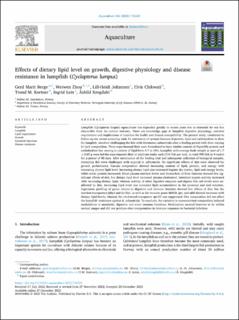| dc.contributor.author | Berge, Gerd Marit | |
| dc.contributor.author | Zhou, Weiwen | |
| dc.contributor.author | Johansen, Lill-Heidi | |
| dc.contributor.author | Chikwati, Elvis Mashingaidze | |
| dc.contributor.author | Kortner, Trond M. | |
| dc.contributor.author | Lein, Ingrid | |
| dc.contributor.author | Krogdahl, Åshild | |
| dc.date.accessioned | 2023-01-17T08:29:54Z | |
| dc.date.available | 2023-01-17T08:29:54Z | |
| dc.date.created | 2023-01-15T17:27:17Z | |
| dc.date.issued | 2023 | |
| dc.identifier.citation | Aquaculture. 2023, 566 1-14. | |
| dc.identifier.issn | 0044-8486 | |
| dc.identifier.uri | https://hdl.handle.net/11250/3043854 | |
| dc.description.abstract | Lumpfish (Cyclopterus lumpus) aquaculture has expanded greatly in recent years due to demands for sea lice cleanerfish from the salmon industry. There are knowledge gaps in lumpfish digestive physiology, nutrient requirement and implications of nutrition for health and disease susceptibility. The present study, conducted to follow up our recent screening trials for estimation of optimal balance of protein, lipid and carbohydrate in diets for lumpfish, involved challenging the fish with Aeromonas salmonicida after a feeding period with diets varying in lipid composition. Three experimental diets were formulated to have similar content of digestible protein and carbohydrate but varying in content of lipid from 6.7 to 18%. Lumpfish with average body weight at start of 1.7 ± 0.03 g were fed the experimental diets in triplicate tanks each (110 fish per tank, in total 990 fish in 9 tanks) for a period of 90 days. After termination of the feeding trial and subsequent collection of biological samples, remaining fish were challenged with atypical A. salmonicida. No significant effects of diet were observed for growth performance. Carcass composition showed increasing content of lipid, protein, and energy with increasing dietary lipid level. Increasing dietary lipid also increased hepatic dry matter, lipid and energy levels, while crude protein decreased. Blood plasma nutrient levels and biomarkers of liver function showed few significant effects of diet, but dietary lipid level increased plasma cholesterol. Intestinal trypsin activity increased with increasing dietary lipid, whereas activity of other digestive enzymes and digesta bile salt levels were unaffected by diet. Increasing lipid level also increased lipid accumulation in the proximal and mid intestine. Expression profiling of genes related to digestive and immune function showed few effects of diet, but the nutrient transporters fabp2 and slc15a1, as well as the immune genes MHCII, igm, and nfkb showed increases with dietary lipid levels, whereas the cholesterol transporter npc1l1 was suppressed. Diet composition did not affect the lumpfish’ resistance against A. salmonicida. To conclude, the variation in macronutrient composition induced modulations in metabolic, digestive and some immune functions. Modulations seemed however to be within normal ranges and did not produce clear compromises in immune responses to bacterial infection. | |
| dc.description.abstract | Effects of dietary lipid level on growth, digestive physiology and disease resistance in lumpfish (Cyclopterus lumpus) | |
| dc.language.iso | eng | |
| dc.title | Effects of dietary lipid level on growth, digestive physiology and disease resistance in lumpfish (Cyclopterus lumpus) | |
| dc.title.alternative | Effects of dietary lipid level on growth, digestive physiology and disease resistance in lumpfish (Cyclopterus lumpus) | |
| dc.type | Peer reviewed | |
| dc.type | Journal article | |
| dc.description.version | publishedVersion | |
| dc.source.pagenumber | 1-14 | |
| dc.source.volume | 566 | |
| dc.source.journal | Aquaculture | |
| dc.identifier.doi | 10.1016/j.aquaculture.2022.739209 | |
| dc.identifier.cristin | 2107164 | |
| dc.relation.project | Nofima AS: 12767 | |
| dc.relation.project | Fiskeri- og havbruksnæringens forskningsfinansiering: 901563 | |
| cristin.ispublished | true | |
| cristin.fulltext | original | |
| cristin.qualitycode | 2 | |
